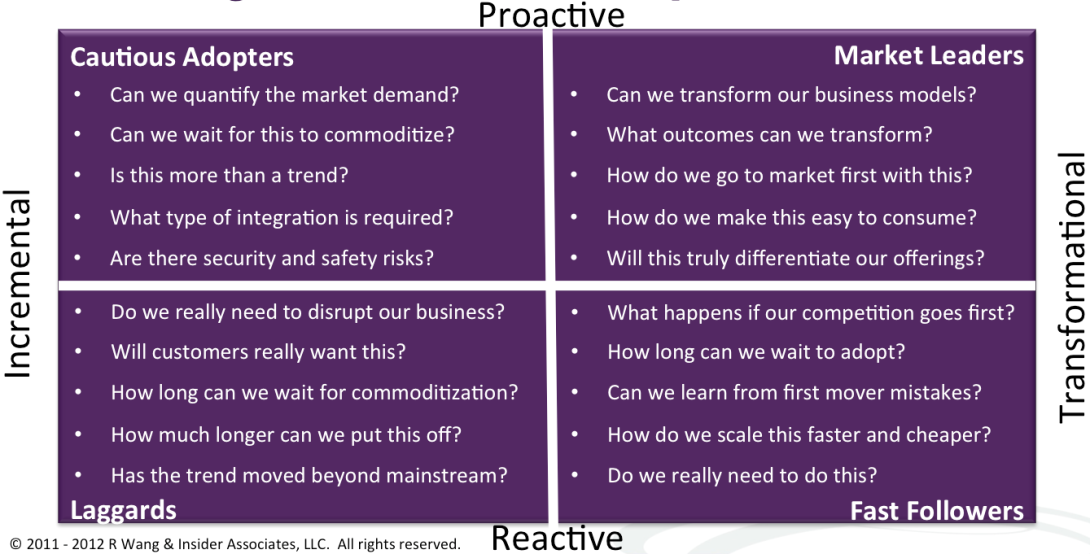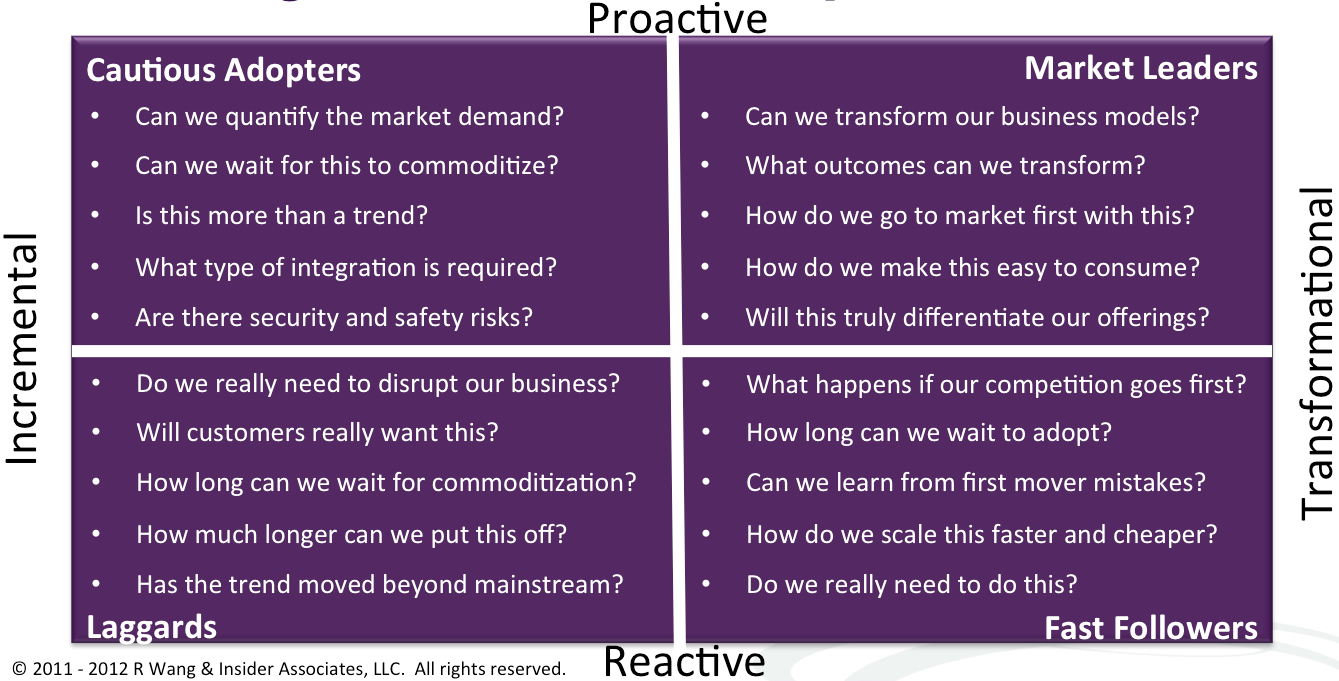
Monday's Musings: Understand The Four Organizational Personas Of Disruptive Tech Adoption

Pace of Innovation Exceeds Ability To Consume
Rapid innovation, flexible deployment options, and easy consumption models create favorable conditions for the proliferation of disruptive technology. In fact, convergence in the five pillars of enterprise disruption (i.e. social, mobile, cloud, big data, and unified communications), has led to new innovations and opportunities to apply disruptive technologies to new business models. New business models abound at the intersection of cloud and big data, social and mobile, social and unified communications, and cloud and mobile.
Unfortunately, most organizations are awash with discovering, evaluating, and consuming disruptive technologies. Despite IT budgets going down from 3 to 5% year over year, technology spending is up 18 to 20%. Why? Amidst constrained budgets, resources, and time limits, executives are willing to invest in disruptive technology to improve business outcomes. Consequently, successful adoption is the key challenge in consuming this torrent of innovation. This rapid pace of change and inability to consume innovation detract organizations from the realization of business value.
Organizations Fall Into Four Personas Of Disruptive Technology Adoption
A common truism in the industry is "Culture trumps technology". As organizations apply methodologies such as Constellation's DEEPR Framework in improving adoption, leaders must first determine which of the four personas best fits their organization's appetite for consuming and innovating with disruptive technologies.
The personas of disruptive technology adoption assess organizational culture in two key axes (see Figure 1). The first is how incremental or transformational an organization looks at applying disruptive technology to business models. The second assesses how proactive or reactive an organization is in carrying out new initiatives. Based on these dimensions, the four personas include:
- Market leaders. Market leaders prefer to drive transformational innovation. They look at technologies as enablers in disrupting business models. They see competitive differentiation in delivering outcomes to customers. Market leaders accept failure as part of the innovation process. They fail fast and move on.
- Fast followers. Fast followers prefer to react to the success of market leaders and their experiments. When they sense success, they tend to jump in. Fast followers do not like to fail and rapidly apply lessons learned from market leaders into their road maps. Fast followers tend to deliver scale in the markets as a counter balance to arriving later in the market.
- Cautious adopters. Cautious adopters proactively deliver incremental innovation. They tend to take a more measured approach and spend more time studying how they can improve an existing success than creating a transformational change. Cautious adopters often come from regulated industries where security and safety are paramount objectives.
- Laggards. Laggards tend to procrastinate on applying innovations to their business models. They prefer not be bothered by trends and will only react when the trends have moved beyond mainstream. They see value in waiting as prices will drop over time as success rates increase over time. Laggards enjoy waiting.
During the interviews and discussions with the 2012 Constellation SuperNova award participants, key questions emerged in the decision process on whether to adopt or pass on a disruptive technologies. These questions aligned well with the four personas of disruptive technology adoption.
Figure 1. Organizations Should Understand Which Persona Of Disruptive Tech Adoption Describes Them Best
The Bottom Line: Apply Adoption Strategies To Persona Types
Executives should look at the four personas and determine which set of questions would best reflect how their organization approaches disruptive technology. Based on the four personas, executives can expect the following:
- Market leaders challenged to determine what not to adopt. Market leaders need a good process and criteria to determine what technologies to pass on. Seasoned organizations have developed disciplined methodologies to determine what to adopt and what not to adopt.
- Fast followers must learn how to scale and when to lead. Scaling innovation is difficult. However, fast followers prepare their culture to make rapid shifts. Leaders establish trigger points and prepare their organization for the potential shift. Fast followers will take the lead when they see a significant advantage. However, for the most part, fast followers prefer to learn from the market leaders and wait for the right opportunity to react.
- Cautious adopters must move out of their six sigma mindset to grow. Proactive incremental innovation leads to steady successes. However, breakthrough and transformational innovation requires a different culture. Both can co-exist in an organization but a separate team must be established to push the boundaries. Cautious adoption traits should be pushed out to the operating level and emerge as every employees skill set. Transformational innovation techniques should be paired with quantifiable metrics.
- Laggards will fall behind. The corporate digital divide between the those who apply disruptive technologies to new business models and those who choose to wait and see will continue to grow. The business model shifts have destroyed iconic companies from Kodak to Sears. Without an incentive to move beyond a reactive and incremental approach, laggards will be overtaken by more agile and innovative organizations.
Your POV.
Ready to fight change management and adoption head on? Have a story on how you’ve applied disruptive technology? Submit for the 2013 SuperNova Awards at SuperNovaAwards (at) ConstellationRG (dot) com
Add your comments to the blog or send us a comment at R (at) SoftwareInsider (dot) org or R (at) ConstellationRG (dot) com
Please let us know if you need help with developing your disruptive technology adoption strategy.
Related Research
Monday’s Musings: The New Engagement Platform Drives The Shift From Transactions
Trends: The Battle For CMO Mind Share
Tuesday’s Tip: Why Context Matters – Forget Real-Time, Achieve Right-Time
Tuesday’s Tip: The Big Question In Big Data Is…What’s The Question?
Tuesday’s Tip: Dealing With The Real Problem In Social Business Adoption – The People!
Monday’s Musing: Avoiding Social Media Fatigue Through Engagement
Monday’s Musings: Why Are Innovative CIO’s Betting Less On Cloud And Virtualization?
Monday’s Musings: Seven Basic Privacy Rights Users Should Demand For Social Business
Best Practices: Five Simple Rules For Social Business
Research Report: How The Five Pillars Of Consumer Tech Influence Enterprise Innovation
Research Report: Next Gen B2B and B2C E-Commerce Priorities Reflect Macro Level Trends
Disclosures
Although we work closely with many mega software vendors, we want you to trust us. For the full disclosure policy, stay tuned for the full client list on the Constellation Research website.
* Not responsible for any factual errors or omissions. However, happy to correct any errors upon email receipt.
Copyright © 2001 – 2012 R Wang and Insider Associates, LLC All rights reserved.
Contact the Sales team to purchase this report on a a la carte basis or join the Constellation Customer Experience!
 R "Ray" Wang
R "Ray" Wang R "Ray" Wang
R "Ray" Wang